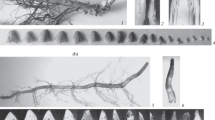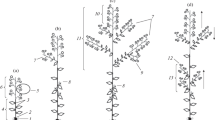Abstract
Despite the considerable interest of many researchers in the Celastrales order, which is largely due to the great diversity of structural features and almost cosmopolitan distribution (except for some arid regions), no comprehensive biomorphological analysis of its representatives has been undertaken so far. The goal of this work is to analyze the structural and rhythmological features of shoots and shoot systems (vegetative and reproductive) of representatives of the Celastrales order, the volume of which is accepted according to the latest data of molecular phylogenetics (APG IV). The main working tool of such an analysis is the concept of architectural models. Among the studied representatives of the order, the following architectural models are identified (Hallé et al., 1978): Rauh, Attims, Champagnat, Mangenot, Scarrone, Stone, McClure, and Tomlinson. The shoot systems belong to three types: (1) polycarpic polycyclic with monopodial or acrosympodial growth and intercalary or pseudoterminal inflorescences with an orthotropic, plagiotropic, and/or mixed orientation of shoots in space and with sylleptic and proleptic shoots at the rhythm of development; (2) monocarpic mono- and dicyclic and terminal inflorescences; and (3) monocarpic monocyclic—once blooming, with sympodial growth and terminal inflorescences and with elongated or shortened shoots. In all these cases, the nature of the blooming of flowers is basipetal. For herbaceous and semiwood representatives (Parnassia, Stackhousioideae), models of shoot formation revealed by Russian biomorphologists are also used (Serebryakova, 1981): monopodial rosette (generative shoots monocarpic monocyclic, with single flowers, and terminal) and sympodial semirosette (generative shoots are monocarpic monocyclic, but with acropetal blooming of flowers in the inflorescence). The taxon as a whole is characterized by the formation of axillary complexes very different in structure and rhythms of development, which allows successfully using these features in characterizing individual species and in establishing evolutionary trends. Thus, for representatives of the Celastrales order, the structural diversity of shoot systems has been revealed which is the basis for the formation of different biomorphs. A high degree of ecological and morphological plasticity is manifested in the individual and intraspecific polymorphism of shoots, the dependence of the ratio of different types of shoots on environmental conditions, the possibility of changing the model during ontogenesis, and the formation of models of transitional character (Celastrus, Tripterygium). The possibility of rapid transformation of the entire shoot system under extreme environmental conditions by the example of the genus Parnassia and the subfamily Stackhousioideae is shown.





Similar content being viewed by others
REFERENCES
APG IV, 2016. https://en.wikipedia.org/wiki/APG_IV_ system.
Golovach, A.G., Liany, ikh biologiya i ispol’zovanie (Lianas: Biology and Use), Leningrad: Nauka, 1973.
Hallé, F., Oldeman, R.A.A., and Tomlinson, P.B., Tropical Trees and Forests: An Architectural Analysis, Berlin: Springer-Verlag, 1978.
Iordanskaya, N.N. and Serebryakov, I.G., Morphogenesis of life form of shrub Euonymus verrucosa Scop., Bot. Zh., 1954, vol. 39, no. 5, pp. 768–773.
Istomina, I.I. and Bogomolova, N.N., Multivariance of ontogenesis and life forms of forest shrubs, Byull. Mosk. O-va. Ispyt. Prir., Otd.Biol., 1991, vol. 96, no. 4, pp. 68–78.
Khokhryakov, A.P., Zakonomernosti evolyutsii rastenii (Evolution of the Plants), Novosibirsk: Nauka, 1975.
Khokhryakov, A.P., Evolyutsiya biomorf rastenii (Evolution of the Plant Biomorphs), Moscow: Nauka, 1981.
Koriba, K., On periodicity of tree-grow in the tropics with reference to the mode of branching, the leaf-fall, and the formation of the resting bud, Gardensʼ Bull., 1958, vol. 17, no. 1, pp. 3–79.
Kuznetsova, T.V., Inflorescence morphology: current status, Itogi Nauki Tekh.,Ser.: Biol., 1991, vol. 12, pp. 51–174.
Kuznetsova, T.V., Reduction of an inflorescence: the nature and role of reduction in the evolution of modular organisms, Zh. Obshch. Biol., 1998, vol. 59, no. 1, pp. 74–103.
Loesener, Th., Celastraceae, Hippocrateaceae, in Die Naturlishen Pflanzenfamilien, Engler, A. and Prantl, K., Eds., Leipzig: W. Engelmann, 1942, vol. 20B, pp. 87–197, 198–231.
Mazurenko, M.T., Life forms of creeping forest plants, Bot. Zh., 1978, vol. 63, no. 4, pp. 593–603.
Mazurenko, M.T. and Khokhryakov, A.P., Struktura i morfogenez kustarnikov (The Structure and Morphogenesis of Shrubs), Moscow: Nauka, 1977.
Nedoluzhko, V.A., Drevesnye rasteniya: Problema evolyutsii zhiznennykh form (Wood plants: Evolution of Life Forms), Vladivostok: Dla’nauka, 1997.
Osmanova, G.O., Shivtsova, I.V., and Ivanova, T.V., Ontogenesis of Parnassia palustris L., in Ontogeneticheskii atlas lekarstvennykh rastenii (Ontogenic Atlas of Medical Plants), Yoshkar-Ola: Mariisk. Gos. Univ., 2002, vol. 3, pp. 176–180.
Savinov, I.A., Architecture models in analysis of shoot systems of members of family Celastraceae R.Br., Vestn. Tversk. Gos. Univ., Ser. Biol. Ekol., 2008, no. 9, pp. 224–227.
Serebryakov, I.G., Morfologiya vegetativnykh orgnaov vysshikh rastenii (Morphology of Vegetative Organs of Higher Plants), Moscow: Sovetskaya Nauka, 1952.
Serebryakov, I.G., Ratio of external and internal factors in annual rhythm of plant ontogenesis, Bot. Zh., 1966, vol. 51, no. 7, pp. 923–938.
Serebryakova, T.I., Modern theory about life form of the plants, Itogi Nauki Tekh.,Ser.: Bot., 1972, vol. 1, pp. 84–169.
Serebryakova, T.I., Life forms and models of shoot formation of terrestrial-creep perennial plants, in Zhiznennye formy: struktura, spektry i evolyutsiya (Life Forms: Structure, Diversity, and Evolution), Moscow: Nauka, 1981, pp. 161–179.
Simmons, M.P., Celastraceae, in The Families and Genera of Flowering Plants, Vol. 6: Flowering Plants. Dicotyledons: Celastrales, Oxalidales, Rosales, Cornales, Ericales, Kubitzki, K., Ed., Berlin: Springer-Verlag, 2004, pp. 29–64.
Sovremennye podkhody k opisaniyu struktury rasteniya (Modern Approaches to Description of the Plant Morphology), Savinykh, N.P. and Bobrov, Yu.A., Eds., Kirov: Loban’, 2008.
Timonin, A.K., Role morphology in botany, Trudy IX Shkoly po teoreticheskoi morfologii rastenii “Tipy skhodstva i printsypy gomogizatsii v morfologii rastenii” (Proc. IX School on Theoretical Plant Morphology “Types of Resemblance and Homologization Principles in the Plant Morphology”), Oskol’skii, A.A., Sokolov, D.D., and Timonin, A.K., Eds., St. Petersburg, 2001, pp. 10–17.
Tzvelev, N.N., Problemy teoreticheskoi morfologii i evolyutsii vysshikh rastenii (Theoretical Morphology and Evolution of Higher Plants), Moscow: KMK, 2005.
Zhmylev, P.Yu., Alekseev, Yu.E., Karpukhina, E.A., and Balandin, S.A., Biomorfologiya rastenii: Illyustrirovannyi slovar’ (Biomorphology of the Plants: Illustrated Dictionary), Moscow: Mosk. Gos. Univ., 2005.
Author information
Authors and Affiliations
Corresponding author
Ethics declarations
Conflict of interests. The authors declare that they have no conflicts of interest.
Statement on the welfare of animals. This article does not contain any studies involving animals performed by any of the authors.
Additional information
Translated by T. Borisova
Rights and permissions
About this article
Cite this article
Savinov, I.A. Architectural Analysis of Representatives of the Celastrales Order: Structure and Rhythm of Shoot Development in Connection with Adaptations of Species to Different Environmental Conditions. Contemp. Probl. Ecol. 13, 300–308 (2020). https://doi.org/10.1134/S1995425520030099
Received:
Revised:
Accepted:
Published:
Issue Date:
DOI: https://doi.org/10.1134/S1995425520030099




